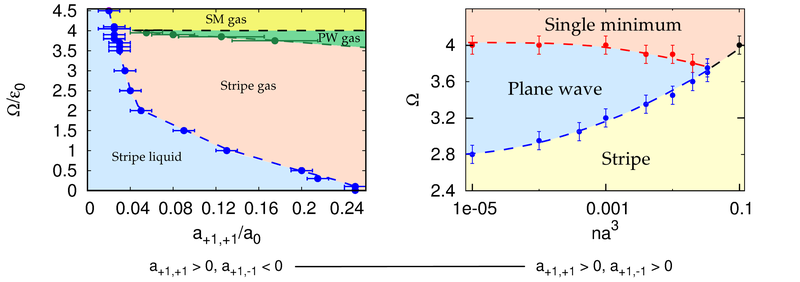Juan Sánchez-Baena defends his thesis on correlations in ultrafred quantum systems with spin-orbit coupling
Dec 16, 2020
Juan Sánchez-Baena defended his thesis co-directed by Jordi Boronat Medico and Ferran Mazzanti Castrillejo on December 14 at the North Campus. Titled "Correlations to ultrafreds quantum gases with spin-orbit coupling", the thesis presents a study on the effect of correlations induced by interactions between particles on systems that are under the influence of spin-orbit potentials.
The evaluation of the effects of correlations in quantum systems constitutes a laborious task since it is not possible to follow standard mean field approaches when solving the Schrödinger equation. We present two approaches to fulfill this goal: the development and application of quantum Monte Carlo methods and the realization of beyond mean field calculations following the Bogoliubov-de Gennes formalism. Regarding the first approach, we show how to modify the standard Diffusion Monte Carlo (DMC) algorithm such that it can sample SOC interactions. We develop the formalism of two DMC methods suited to the simulation of SOC systems: the Discrete Spin T-moves DMC (DTDMC) and the Spin-Integrated DMC (SIDMC). Since the ground state wave function of a SOC system is complex, these methods work under the fixed phase approximation, meaning that they can not provide exact ground state estimates. DTDMC corresponds to an adaptation to discrete spin variables of a preexisting SOC DMC algorithm. This method requires the definition of an effective Hamiltonian to cure a sign problem in the propagator, which worsens the quality of its estimations. On the other hand, SIDMC, a completely original method developed in this thesis, is able to bypass the definition of the effective Hamiltonian by propagating the spin-integrated wave function of the system in imaginary time. As a consequence, SIDMC yields physical estimates closer to their ground state values. However, the SIDMC method is unable to sample spin-dependent two-body interactions. Through the use of the DTDMC algorithm, we elaborate the extension to the correlated regime of the phase diagram of a many-body Raman SOC system with spin-dependent two-body interactions. The results show that correlations favor the exotic stripe phase, which features density modulations, meaning that the stripe region of the phase diagram is enlarged as the level of correlations is increased. We also report results for the pair-distribution function, the static structure factor, the one-body density matrix and the superfluidity of the system. We show that the superfluid fraction across the stripes is non-zero, meaning that the stripes are superfluid, a consistent result with previous mean-field calculations.
Regarding the second prescription to account for correlations in a SOC system, we follow the Bogoliubov-de Gennes formalism in order to compute the first order correction by correlations to the mean field result. We compute the Lee-Huang-Yang (LHY) energy correction for a Raman SOC system in the stripe phase for the first time. As an application, we are able to determine the role played by quantum fluctuations in a Raman SOC system in the stripe phase that is unstable at the mean field level due to attractive interactions. Such system is currently under experimental development. The results show that quantum fluctuations stabilize the collapse predicted by mean field theory, giving rise to a stabilized gas, or a stabilized liquid, depending on the values of the parameters of the Hamiltonian. Moreover, the finite system supports the existence of self-bound droplets as its ground state. These droplets show density modulations, induced by SOC. Therefore, they represent a novel state of matter in the field of ultracold atoms that combines the self-bound character of liquids, density modulations reminiscent of solids, and superfluidity. We also provide a phenomenological analytical functional of the density in order to ease the evaluation of the LHY energy.
Finally, we also report a brief analysis of a quantum many-body system that features Spin Orbital Angular Coupling (SOAC). We perform DTDMC calculations in order to evaluate the impact of correlations in the system. We show that the mean field and DTDMC predictions for the energy and spin polarization agree in the range of parameters considered, meaning that correlations are not very relevant.

Share: